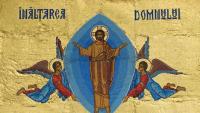
Only Luke gives a detailed account of the ascension and this account is in Acts. His gospel relates the life, death and resurrection of Jesus; Acts tells the story of the early church. The ascension forms a kind of bridge between the two. For all the gospel writers the resurrection of the Lord was the key event: it is what the apostles preached to the people. Jesus, the second person of the Trinity, became man as Emmanuel, "God with us". As he said to Philip at the Last Supper, “Whoever has seen me has seen the Father” (John 14:9). In Jesus we see God and how God acts. Jesus’ death on the cross seemed a failure of his mission and a triumph of wordly authorities; his resurrection proved otherwise. The description of his ascension into Heaven is a celebration of his triumph. It resembles other accounts of the apotheoses of great men like Elijah and Augustus; the cloud enveloping him being an image of God. The true leave-taking was at the Last Supper where the disciples were sorrowful. Now, however, they were joyful (Luke 24:52). They did not seem to feel abandoned. Jesus had promised that he would be with them always to the end of the age (Matt 28:20). In fact they themselves would become the mystical body of Jesus working in the world as he did, and as we also try to do.